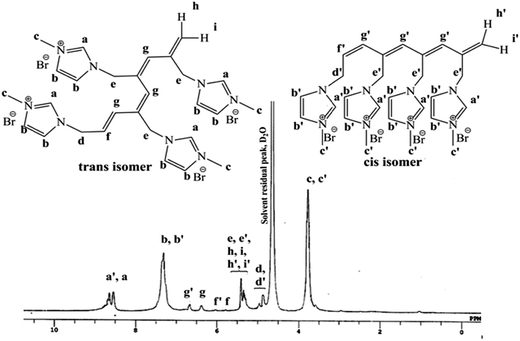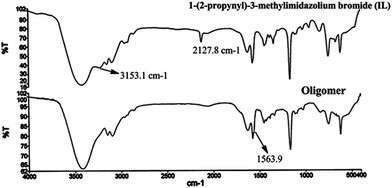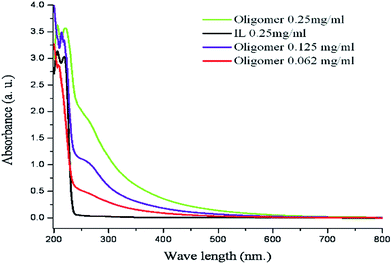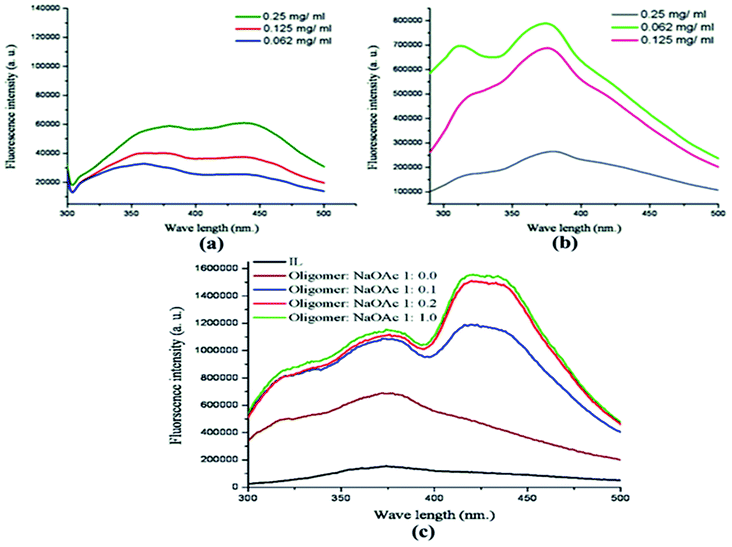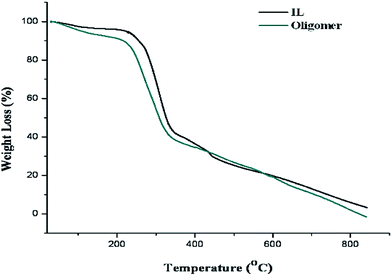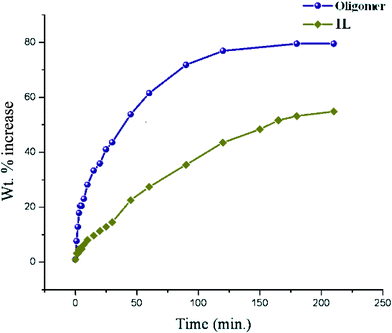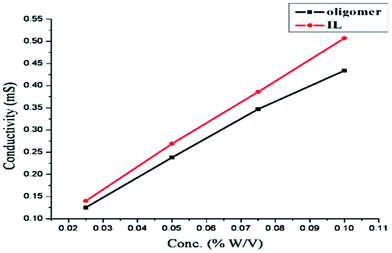Study of the properties of luminescent poly[1-(2-propynyl)-3-methylimidazolium bromide] oligomers prepared using a Mo(CO)6/phenol catalyst†
Kheyanath Mitra,
Shikha Singh and
Biswajit Ray*
Department of Chemistry, Faculty of Science, Banaras Hindu University, Varanasi, UP 221005, India. E-mail: biswajitray2003@yahoo.co.in
First published on 13th February 2015
Abstract
Luminescent poly[1-(2-propynyl)-3-methylimidazolium bromide] oligomers (degree of polymerization = 4), having a conjugated polyacetylene type backbone and imidazolium as pendant group, have successfully been synthesized with 55% yield by polymerizing 1-(2-propynyl)-3-methylimidazolium bromide ionic liquid using Mo(CO)6/phenol as catalyst (89![[thin space (1/6-em)]](https://www.rsc.org/images/entities/char_2009.gif) :
:![[thin space (1/6-em)]](https://www.rsc.org/images/entities/char_2009.gif) 1
1![[thin space (1/6-em)]](https://www.rsc.org/images/entities/char_2009.gif) :
:![[thin space (1/6-em)]](https://www.rsc.org/images/entities/char_2009.gif) 89) at 120 °C. 1H NMR, 13C NMR, FTIR, ESI-MS, and UV-Vis studies have confirmed its formation. It has shown a strong increase in fluorescence intensity compared to the monomer which is unusual for monosubstituted polyacetylenes. Further addition of sodium acetate has enhanced its fluorescence properties considerably. Thermal stability and solution conductivity of it have decreased, while its hygroscopic property has increased with respect to its monomer.
89) at 120 °C. 1H NMR, 13C NMR, FTIR, ESI-MS, and UV-Vis studies have confirmed its formation. It has shown a strong increase in fluorescence intensity compared to the monomer which is unusual for monosubstituted polyacetylenes. Further addition of sodium acetate has enhanced its fluorescence properties considerably. Thermal stability and solution conductivity of it have decreased, while its hygroscopic property has increased with respect to its monomer.
1. Introduction
Conjugated polymers with delocalized π-electron systems have been developed as a class of materials which are exploited extensively in applications like LEDs, solar cells, electrochromic devices, chemo and biosensors etc.1,2 Polyacetylene (PA) type conjugated polymers are the simplest amongst the conjugated polymers and the discovery of metallic conductivity of doped PA films led to the Nobel prize in 2000.3 But the simple PA has some drawbacks like poor solubility, infusibility and insufficient stability, which has been solved by tuning the substituents of mono-substituted and di-substituted PAs.2–4 PA polyelctrolytes, having pendant positive and negative groups, can offer many advantages over others like solution processability, and the enhancement of conductivity and light absorption emission properties owing to the presence of both ionic and electronic conductions.2,5–7 Considering these features, acetylenic ionic liquids will be interesting monomers for preparing functionalized PA. Recently, polymerized ionic liquids (PIL), a subclass of polyelectrolytes, have attracted increasing interests at the interface of physics, chemistry, material science and biomedical science as they can provide much broader range of applications because of their tunable physical properties.8 However, most of the PILs have been prepared by polymerization of vinylic ionic liquid monomers.8 The synthesis of polyacetylene type PIL polyelectrolytes using acetylenic ionic liquids is few in literature.2,5,9–11 Prior works on the synthesis of polyacetylene type PIL polyelectrolytes are mainly carried out on pyridinium based PILs, e.g. in situ formation of N-propargyl piridinium halide and self-catalyzed polymerizations during reaction between pyridine and propargyl halide2,9 or, the polymerization of propargyl side chain attached with pyridine ring and formation of ionic conjugated polymer during reaction with halide compounds.10,11 But the studies on the polymerization of alkyne containing imidazolium based ILs are too few in literature and none are well-defined.5,12 In situ polymerization of 1-(2-propynyl)-3-methylimidazolium bromide with carbon nanotube catalyzed by PdCl2 was reported but did not give any detail characterization of polymer formed.12 Very broad molecular weight range of synthesized polymers was reported during RhCl3 catalyzed polymerization of 1-dodecyl-3-propargylimidazolium bromide.5Herein, we report the synthesis of luminescent poly[1-(2-propynyl)-3-methylimidazolium bromide] oligomer (degree of polymerization = 4) by polymerizing 1-(2-propynyl)-3-methylimidazolium bromide, one of the simplest alkyne containing imidazolium based compound,13 in chloroform using molybdenum hexacarbonyl/phenol catalyst14 at 120 °C for the first time. The resulting oligomer is characterized by 1H NMR, 13C NMR, FTIR, ESI-MS, UV-Vis, fluorescence, TGDTA, and DSC. The fluorescence enhancement using sodium acetate, moisture uptake capacity and solution conductivity of this oligomer have been studied and compared with its monomer.
2. Materials and methods
2.1 Materials
1-Methylimidazole (Sigma-Aldrich, USA), propargyl bromide (80% solution in toluene) (Sigma-Aldrich, USA), molybdenum hexacarbonyl (Sigma-Aldrich, USA), methanol (CDH, India), acetone (CDH, India), sodium acetate (AR, Loba chemi, India) were used as received. Phenol (CDH, India) was distilled under vacuum. Chloroform (CDH, India) was dried and distilled over calcium chloride. Toluene (Loba chemi, India) was dried and distilled over sodium and benzophenon.2.2 Synthesis of 1-(2-propynyl)-3-methylimidazolium bromide
Synthesis was carried out as per reported method.15 A three neck R.B. flask containing a Teflon-coated magnetic bar connected to a Schlenk line was dried and degassed via 3 cycles of vacuum and refilling with dry nitrogen. To it, degassed propargyl bromide (11.2 mL of 80% solution in toluene, 75.5 mmol) was added under nitrogen. Then, the reaction mixture was cooled down under nitrogen purging to −10 °C by immersing in acetone/liquid nitrogen bath. To it, deoxygenated 1-mthylimidazole (5 mL, 62.7 mmol) was added drop wise under constant stirring. Then, the system was allowed to attain the room temperature (35 °C) slowly and 25 mL degassed toluene was added to it. The reaction was continued for 12 h under constant stirring. Solvent and remaining reactants were removed under vacuum. Finally, the product was dried under vacuum at 40 °C for 48 h. Gravimetric yield: 12.16 g (86.2%). 1H NMR (300 MHz, CDCl3): δ (ppm) 10.61 (s, N–CH![[double bond, length as m-dash]](https://www.rsc.org/images/entities/char_e001.gif) N), 7.55 and 7.38 (s, N–CH
N), 7.55 and 7.38 (s, N–CH![[double bond, length as m-dash]](https://www.rsc.org/images/entities/char_e001.gif) CH), 5.41 (s, N–CH2), 4.11 (s, N–CH3), 2.72 (s,
CH), 5.41 (s, N–CH2), 4.11 (s, N–CH3), 2.72 (s, ![[triple bond, length as m-dash]](https://www.rsc.org/images/entities/char_e002.gif) CH). (Fig. S1, ESI†) Elemental analysis: (calculated) C: 41.82%, H: 4.51%, N: 13.93%, Br: 39.74; (experimental) C: 41.7%, H: 4.6%, N: 13.9%, Br: 39.8.
CH). (Fig. S1, ESI†) Elemental analysis: (calculated) C: 41.82%, H: 4.51%, N: 13.93%, Br: 39.74; (experimental) C: 41.7%, H: 4.6%, N: 13.9%, Br: 39.8.
2.3 Synthesis of poly[1-(2-propynyl)-3-methylimidazolium bromide] (Scheme 1)
In a dry and nitrogen purged sealing tube, 1-(2-propynyl)-3-methylimidazolium bromide (330 mg, 1.6 mmol) and molybdenum hexacarbonyl (5 mg, 0.018 mmol) was added under constant nitrogen purging. To it, degassed phenol (0.16 mL, 1.6 mmol) and degassed chloroform (solvent, 1 mL) were added. Finally, the reaction mixture was degassed via 3 cycles of freeze–thaw method and sealed under nitrogen atmosphere and emerged in an oil bath preheated at 120 °C for 19 h.14 The reaction was stopped by freezing in liquid nitrogen. After evaporating solvent under vacuum, the resulting reaction mixture was dissolved in methanol and precipitated from chloroform twice and dried under vacuum for 2 h. Finally, it was again dissolved in methanol and precipitated from acetone. The product was then dried under vacuum for 24 h. A deep brown, highly hygroscopic, sticky solid was obtained and stored in a desiccator. Gravimetric yield: 181.5 mg (55%). 1H NMR (300 MHz, D2O): δ (ppm) 8.5–8.6 (d, N–CH![[double bond, length as m-dash]](https://www.rsc.org/images/entities/char_e001.gif) N), 7.31 (s, N–CH
N), 7.31 (s, N–CH![[double bond, length as m-dash]](https://www.rsc.org/images/entities/char_e001.gif) CH), 6.37 and 6.66 (s, CH
CH), 6.37 and 6.66 (s, CH![[double bond, length as m-dash]](https://www.rsc.org/images/entities/char_e001.gif) CH), 5.30–5.40 (m, N–CH2, terminal C
CH), 5.30–5.40 (m, N–CH2, terminal C![[double bond, length as m-dash]](https://www.rsc.org/images/entities/char_e001.gif) CH2, terminal CH
CH2, terminal CH![[double bond, length as m-dash]](https://www.rsc.org/images/entities/char_e001.gif) C), 4.85–4.96 (m, terminal N–CH2), 3.80 (s, N–CH3). (Fig. 1) 13C NMR (75 MHz, D2O): δ (ppm) 137.2, 133.6, 132.5, 131.5, 130.0, 127.5, 124.9, 123.8, 120.3, 116.2, 52.8, 50.6, 48.8, 36.8 (Fig. S2, ESI†).
C), 4.85–4.96 (m, terminal N–CH2), 3.80 (s, N–CH3). (Fig. 1) 13C NMR (75 MHz, D2O): δ (ppm) 137.2, 133.6, 132.5, 131.5, 130.0, 127.5, 124.9, 123.8, 120.3, 116.2, 52.8, 50.6, 48.8, 36.8 (Fig. S2, ESI†).
2.4 Characterization methods
1H NMR and 13C NMR spectra were recorded on a JEOL AL300 FTNMR (300 MHz) at ambient temperature in CDCl3 or, D2O as solvent and were reported in parts per million (δ) from the internal tetramethylsilane or, residual solvent peak.Elemental analysis was performed in CE440-ELEMENTAL ANALYZER, EXTER ANALYTICAL. INC. FTIR spectra were recorded in Perkin-Elmer Spectrum version 10.03.05 spectrometer instrument using KBr pellet. ESI-MS was recorded using amaZon SL BRUKER instrument. The UV-Visible spectra were recorded on Shimadzu-1700 UV-Vis spectrophotometer using solutions of requisite concentrations in deionized water.
Photoluminescence spectra and fluorescence enhancement study were recorded in Fluoromax-4 spectrofluoremeter (HORIBA SCI.) using solutions of requisite concentrations in deionized water.
TGDTA was performed using Perkin-Elmer STA 6000 instrument under nitrogen atmosphere at the heating rate of 10 °C min−1. DSC was carried out under nitrogen atmosphere using Mettler STAR SW 10.00 instrument. The instrument was calibrated with indium before use. The samples were first heated to 150 °C at 10 °C min−1 heating rate and then quenched to −50 °C. A heating rate of 10 °C min−1 was used for second heating run. Results were reported from the second heating run except that of IL monomer which was reported from its first run. The midpoint of the heat capacity change was taken as glass transition temperature (Tg) and the maximum of endothermic peak was taken as melting temperature (Tm).
Solution conductivities were recorded using ELICO conductivity meter CM 180.
3. Results and discussion
3.1 Synthesis and characterization
The polymerization of 1-(2-propynyl)-3-methylimidazolium bromide using molybdenum hexacarbonyl/phenol catalyst (89![[thin space (1/6-em)]](https://www.rsc.org/images/entities/char_2009.gif) :
:![[thin space (1/6-em)]](https://www.rsc.org/images/entities/char_2009.gif) 1
1![[thin space (1/6-em)]](https://www.rsc.org/images/entities/char_2009.gif) :
:![[thin space (1/6-em)]](https://www.rsc.org/images/entities/char_2009.gif) 89) at 120 °C in chloroform media for 19 h was resulted with 55% yield (Scheme 1, Table 1). The resulting polymer was characterized by 1H NMR, 13C NMR, FTIR and ESI-MS spectroscopies.
89) at 120 °C in chloroform media for 19 h was resulted with 55% yield (Scheme 1, Table 1). The resulting polymer was characterized by 1H NMR, 13C NMR, FTIR and ESI-MS spectroscopies.
| 1-(2-Propynyl)-3-methylimidazolium bromide | Molybdenum hexacarbonyl | Phenol | Gravimetric yield of oligomer | DP/molecular wt (from ESI MS) |
|---|---|---|---|---|
| 330 mg (1.6 mmol) | 5 mg (0.018 mmol) | 0.16 mL (1.6 mmol) | 181.5 mg; 55% | 4/806 Da |
In the 1H NMR spectrum (Fig. 1) of the polymer measured in D2O, the peaks at 6.37 and 6.66 ppm corresponding to the vinylic protons (g, g′) of the conjugated backbone chain indicates the formation of both cis and trans stereoisomers without selectivity.2,5,16 The peaks at 8.5–8.6 ppm (a, a′) and 7.31 ppm (b, b′) correspond to the methine protons of the imidazolium rings. The peak at 3.80 ppm (c, c′) corresponds to N–CH3 group. The peaks at 5.30–5.40 ppm correspond to the methylene protons of the pendant part (e, e′) along with the chain end protons of the conjugated backbone (h, h′, i, i′). The peaks at 4.85–4.96 ppm (d, d′) correspond to the methylene protons of the terminal pendant group. Observed broadening and splitting of the peaks support the presence of conjugated backbone with different isomers.5,17 Moreover, the corresponding 13C NMR spectrum (Fig. S2, ESI†) confirms the presence of vinylic carbons and the absence of acetylenic carbons. Moreover, the C![[triple bond, length as m-dash]](https://www.rsc.org/images/entities/char_e002.gif) C stretching at 2127.8 cm−1 and C
C stretching at 2127.8 cm−1 and C![[triple bond, length as m-dash]](https://www.rsc.org/images/entities/char_e002.gif) C–H stretching at 3153.1 cm−1 of IL are disappeared in the corresponding FTIR spectrum of the oligomer (Fig. 2) and the appearance of the new peak at 1563.9 cm−1 together with the peak at 1575 cm−1 corresponding to the imidazolium ring stretching indicates the presence of the extended conjugation.5,10,12
C–H stretching at 3153.1 cm−1 of IL are disappeared in the corresponding FTIR spectrum of the oligomer (Fig. 2) and the appearance of the new peak at 1563.9 cm−1 together with the peak at 1575 cm−1 corresponding to the imidazolium ring stretching indicates the presence of the extended conjugation.5,10,12
ESI-MS spectrum of the oligomer (Fig. S4, ESI†) revealed the presence of the molecular ion peaks at 525.1 (tetramer excluding 4 Br− counter anions + K+; calculated mass = 525.28; 30% peak intensity) and at 523.1 (tetramer excluding 4 Br− counter anions and 2H + K+; calculated mass = 523.27; 50% peak intensity). The corresponding calculated molecular weight of the oligomer is 806 Da. Thus, MS result clearly confirms the formation of oligomer with the degree of polymerization (DP) of 4.
This oligomer is soluble mainly in protic polar solvents like water, methanol, ethanol etc. The UV-visible spectrum (Fig. 3) of the aqueous solution of the IL monomer did not show any characteristic absorption up to 245 nm from 800 nm, but the corresponding spectrum of the oligomer showed a solder peak with absorption maxima at 262 nm owing to the π–π* transition of the conjugated double bonds in the backbone chain.
Moreover, the absorption intensities of UV-Vis spectra were increased with increasing concentration of oligomer. It did not show well resolved absorption maxima plausibly because of the shorter chain length of the conjugated backbone.5,17,18 Thus, it strongly supports the formation of oligomer.
3.2 Fluorescence properties
Though strong fluorescence emission of di-substituted PAs owing to the pendant-induced distortion of backbone are well reported but mono-substituted PAs have generally been reported to give weak fluorescence unless prepared by substitution tuning.2,5,19,20 On excitation at 262 nm wavelength, the oligomer interestingly shows a very strong fluorescence emission spectrum with a maximum at 375 nm; while its monomer (IL), on the same excitation, shows very much weaker fluorescence emission spectrum (Fig. 4). The observed strong fluorescence emission of the oligomer may be attributed to the flexibility of its shorter conjugated backbone chain which facilitates its distortion. Moreover, although the fluorescence intensity of IL increases slightly with the increase in its concentration (Fig. 4a), a fluorescence quenching for the oligomer has been observed (Fig. 4b). This quenching is probably caused by the aggregation of larger sized cationic part on increasing concentration.![[thin space (1/6-em)]](https://www.rsc.org/images/entities/char_2009.gif) :
:![[thin space (1/6-em)]](https://www.rsc.org/images/entities/char_2009.gif) 1 weight ratio of the mixture of oligomer and sodium acetate. The attractive interaction between acetate anion and positively charged imidazolium pendant group possibly leads to fluorescence enhancement.2 It is to be noted here that there is also gradual increase in the absorption intensity of the UV-Vis spectra of the oligomer solution (0.125 mg mL−1 concentration)s with higher weight ratios of sodium acetate (Fig. S4, ESI†). Addition of some other anions (Fig. S5, ESI†) also shows the fluorescence enhancement.
1 weight ratio of the mixture of oligomer and sodium acetate. The attractive interaction between acetate anion and positively charged imidazolium pendant group possibly leads to fluorescence enhancement.2 It is to be noted here that there is also gradual increase in the absorption intensity of the UV-Vis spectra of the oligomer solution (0.125 mg mL−1 concentration)s with higher weight ratios of sodium acetate (Fig. S4, ESI†). Addition of some other anions (Fig. S5, ESI†) also shows the fluorescence enhancement.3.3 Thermal properties
Thermogravimetric analysis was performed to know the thermal stability of the oligomer in comparison to its monomer (Fig. 5).Both the oligomer and monomer undergoes slight weight loss in the range 90–130 °C because of the evaporation of the adsorbed moisture, followed by the large mass loss in the range 215–330 °C, owing to backbone chain degradation and nucleophilic attack of halide ion.5,21 Then, both similarly undergo gradual decomposition up to 850 °C. The decomposition onset of IL monomer and oligomer are observed at 225 °C and 215 °C, respectively. The observed early onset for oligomer may be due to the absence of alkyne bond. The observed good thermal stability of the oligomer below 200 °C may be useful for suitable outdoor applications.
The DSC thermograms of oligomer (second heating run) and IL monomer (first heating run) are shown in Fig. 6. The IL monomer has shown the melting temperature (Tm) at 117 °C and glass transition temperature (Tg) at −30 °C.13 The oligomer has showed Tg at 79.2 °C (enlarged in the inset). But, it did not show any endotherm for Tm. Instead, a secondary transition is observed at 114.5 °C probably due to the relaxation of pendant imidazolium ring.22
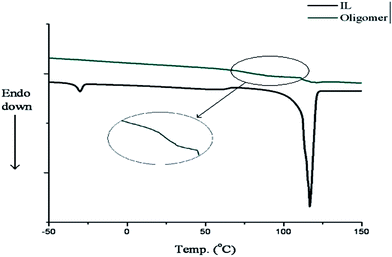 | ||
| Fig. 6 DSC thermogram of IL monomer and oligomer (1st and 2nd heating run, respectively, heating rate 10 °C min−1; N2 atmosphere). | ||
3.4 Study of hygroscopic nature
We have also studied the hygroscopic nature of the oligomer and the IL monomer by monitoring the increase in the weight upon uptake of moister. The corresponding results are shown in Fig. 7.It clearly shows that the oligomer is much more hygroscopic in nature than the monomer IL. As for example, within 2.5 h, oligomer can uptake moisture ∼80 wt% in compare to IL which can uptake ∼55 wt% moisture. This observation indicates that the oligomer is a good candidate for the possible application as moisture sensor.
3.5 Solution conductivity
We have also studied and compared the solution conductivities of IL monomer and the oligomer in deionized water at their different concentrations ranging from 0.02–0.1% (w/v) (Fig. 8).Here, the conductivities of both IL and oligomer increase linearly from 0.14 mS to 0.507 mS and 0.125 to 0.434 mS, respectively, with the increase in concentration as expected. The oligomer found to have lower conductivity than its monomer for the same concentration, which may be attributed to the lesser mobility of the larger size cationic oligomer with respect to its monomeric cationic analog.
4. Conclusion
In conclusion, we have successfully synthesized and characterized novel luminescent poly[1-(2-propynyl)-3-methylimidazolium bromide] oligomer with DP of 4 using Mo(CO)6/phenol catalyst. The resulting oligomer showed much stronger fluorescence intensity in comparison to its monomer. The fluorescence intensity of oligomer also increased with the addition of acetate anion owing to the interaction between imidazolium group and acetate anion. This may make the oligomer promising for fluorescence based application. Further, the oligomer is much more hygroscopic in nature than its monomer which may find application as moisture sensor. The solution conductivity of the oligomer increased linearly from 0.125 to 0.434 mS with increase in its concentration from 0.02 to 0.1% (w/v).Acknowledgements
We thank Banaras Hindu University and University grants Commission, India for financial support. We are thankful to Dr I Tiwari (Dept. of Chemistry, BHU) regarding fluorescence studies. We acknowledge Dr S. Saha and late Prof. S. D. Khattri (Department of Chemistry, BHU) for their initial supports.Notes and references
- H. Jiang, P. Taranekar, J. R. Reynolds and K. S. Schanze, Angew. Chem., Int. Ed., 2009, 48, 4300–4316 CrossRef CAS PubMed.
- C. Zhou, Y. Gao and D. Chen, J. Phys. Chem. B, 2012, 116, 11552–11559 CrossRef CAS PubMed.
- A. J. Heeger, Angew. Chem., Int. Ed., 2001, 40, 2591–2611 CrossRef CAS.
- M. G. Mayershofer and O. Nuyken, J. Polym. Sci., Part A: Polym. Chem., 2005, 43, 5723–5747 CrossRef CAS.
- B. Ringstrand, S. Seifert and M. A. Firestone, J. Polym. Sci., Part B: Polym. Phys., 2013, 51, 1215–2127 CrossRef CAS.
- K. Lee, H. J. Kim and J. Kim, Adv. Funct. Mater., 2012, 22, 1076–1086 CrossRef CAS.
- D. T. Simon, S. Kurup, K. C. Larsson, R. Hori, K. Tybrandt, M. Goiny, E. H. Jager, M. Berggren, B. Canlon and A. Richter-Dahlfors, Nat. Mater., 2009, 8, 742–746 CrossRef CAS PubMed.
- J. Yuan, D. Mecerreyes and M. Antonietti, Prog. Polym. Sci., 2013, 38, 1009–1036 CrossRef CAS PubMed.
- V. A. Karginand and V. A. Kabanov, US Pat., 3658942, 1972.
- S. Subramanyam and A. Blumstein, Macromolecules, 1991, 24, 2668–2674 CrossRef CAS.
- Y. S. Gal, S. H. Jin, J. W. Park and K. T. Lim, J. Polym. Sci., Part A: Polym. Chem., 2009, 47, 6153–6162 CrossRef CAS.
- K. Yinjie, B. Wu, D. Hu, X. Zhang and J. Chen, J. Solid State Electrochem., 2012, 16, 759–766 CrossRef PubMed.
- S. Schneider, G. Drake, L. Hall, T. Hawkins and M. Rosander, Z. Anorg. Allg. Chem., 2007, 633, 1701–1707 CrossRef CAS.
- H. C. M. Vosloo and J. A. K. du Plessis, Polym. Bull., 1993, 33, 273–278 CrossRef.
- E. Samuel and T. Wim, Chem. Commun., 2011, 47, 4177–4179 RSC.
- W. Kemp, Organic Spectroscopy, Palgrave Publishers, 3rd edn, 2011 Search PubMed.
- B. Kiskan and Y. Yagci, Polymer, 2008, 49, 2455–2460 CrossRef CAS PubMed.
- Y. P. Dong, J. W. Y. Lam, H. Peng, K. K. L. Cheuk, H. S. Kwok and B. Z. Tang, Macromolecules, 2004, 37, 6408–6417 CrossRef CAS.
- Q. Zeng, P. Cai, Z. Li, J. G. Qin and B. Z. Tang, Chem. Commun., 2008, 1094–1096 RSC.
- Y. M. Huang, J. W. Y. Lam, K. K. L. Cheuk, W. K. Ge and B. Z. Tang, Macromolecules, 1999, 32, 5976–5978 CrossRef CAS.
- S. Sowmiah, V. Srinivasadesikan, M. C. Tseng and Y. H. Chu, Molecules, 2009, 14, 3780–3813 CrossRef CAS PubMed.
- V. K. Patel, N. K. Viswakarma, A. K. Mishra, C. S. Biswas, P. Maiti and B. Ray, J. Appl. Polym. Sci., 2013, 127, 4305–4317 CrossRef CAS.
Footnote |
| † Electronic supplementary information (ESI) available: Characterization data. See DOI: 10.1039/c4ra13917h |
| This journal is © The Royal Society of Chemistry 2015 |

